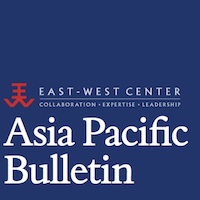SUMMARY
This is AI generated summarization, which may have errors. For context, always refer to the full article.

Japanese Prime Minister Shinzo Abe’s economic revitalization policies have energized Japan over the past year, boosting both corporate and public confidence and lifting the Nikkei stock index to heights unseen in  recent years. The Abe government’s three-pronged strategy of aggressive monetary policy, fiscal policy, and structural reforms aims to eliminate deflationary mindsets after two “lost decades” of economic stagnation, stimulate consumption and investment, and spur new growth. As part of its growth strategy, the Abe government brought Japan into the Trans-Pacific Partnership (TPP) negotiations, presenting significant opportunities to strengthen Japan’s economic relationship with the United States.
recent years. The Abe government’s three-pronged strategy of aggressive monetary policy, fiscal policy, and structural reforms aims to eliminate deflationary mindsets after two “lost decades” of economic stagnation, stimulate consumption and investment, and spur new growth. As part of its growth strategy, the Abe government brought Japan into the Trans-Pacific Partnership (TPP) negotiations, presenting significant opportunities to strengthen Japan’s economic relationship with the United States.
A growing, prosperous Japan benefits the United States. Japan is the fourth-largest US export market, and US subsidiaries of Japanese companies employed more than 680,000 US workers in 2011. The two economies are increasingly integrated through trade, investment, and global supply chains. A TPP agreement will accelerate and further deepen integration by removing significant market access, regulatory, and other barriers in Japan to US exports. Moreover, the recent approval of US shale gas exports to Japan will make energy an increasing area of the bilateral economic partnership.
The Abe government’s growth agenda shares with US domestic economic strategies the goal of spurring innovation to generate new productivity and growth engines. It is valuable to consider the potential impacts these strategies have not only for Japan, but also their interconnectivity with the US economy at a time when both countries face intensifying global competitive pressure. One consideration for policymakers is the matter of where engagement supports Japan’s growth strategies, and presents opportunities for bilateral cooperation in creating new industries and advancing related goals globally.
First, governments play key roles in facilitating conducive environments and policy frameworks for innovation, and in coordinating among various actors – including businesses, universities, non-governmental organizations, and entrepreneurs – from whose interactions innovations emerge. The Japan Revitalization Strategy announced in June 2013 indicates an active role for the Japanese government in advancing these proposals. This is important for enhancing basic research for which government support is vital, such as the proposed establishment of a Japanese version of the National Institutes of Health, along with university reforms.
It will be essential to implement deep structural reforms, such as those required for TPP, electricity deregulation, and in labor and agriculture policy in order to overcome long-recognized constraints to productivity and Japan’s innovation ecosystem. The Abe government should, however, be careful to avoid actions that could inadvertently distort markets, including picking industry and standards champions, and consider appropriate exit strategies for government stimulus in order to allow competitive businesses and entrepreneurs to fully unleash innovative capabilities. These are issues with which the US also grapples, and that present useful opportunities for continued engagement and dialogue around best practices and policy solutions.
Second, coordination around innovation policy is increasingly important within the US-Japan relationship. Center stage for this is TPP, given the role trade and investment play in fostering innovation by encouraging competition and bringing new products, technologies, and ideas across borders. TPP presents opportunities to enhance key elements of innovation frameworks, including stronger intellectual property protections, greater alignment of standards-setting processes, opening market sectors closed to investment, removing localization barriers, improving transparency and eliminating regulatory impediments. Some of these issues remain challenges to foreign businesses in Japan, but on others Japan has strong rules and shared goals with the United States. This makes TPP an important venue for cooperation to ensure a high-standard agreement that encourages innovation in Japan, and fosters a more competitive environment across the Asia-Pacific region for Japanese and US innovations.
The two governments are additionally exploring common issues in clean energy, the Internet economy, and other innovation-driven industries. These dialogues have increasingly incorporated both small and large businesses from both countries, positive for pragmatic discussions on policy, commercial developments, and areas of potential collaboration. Expanding this inclusive approach, and exploring untapped synergies across existing initiatives and institutional lines on cross-cutting innovation topics, could present beneficial opportunities. This includes in new growth areas, such as smart grid systems, health care technologies including regenerative medicine, and services for aging societies.
Third, innovation is borderless and requires a global orientation. Japan is world-leading in its innovation capabilities, but Japanese companies have stumbled in recent years in bringing these assets to global markets. Contributing factors have included business and organizational models, and an inward, domestic focus. The Abe administration’s growth strategy includes a comprehensive set of actions to address these and related challenges in Japan’s innovation ecosystem. These range from incentives for corporate governance reform and business organization, and encouraging more women and high-skilled foreign professionals in the workforce, to attracting foreign direct investment through special economic zones featuring bold regulatory reforms.
Increased engagement with US partners, at multiple levels of government, the private sector, and civil society can support Japan as it moves forward with this agenda. For example, the two governments are discussing opportunities to facilitate more mergers and acquisitions into Japan, which could help introduce more global perspectives and get innovative Japanese goods, services, and ideas out to global markets. Leveraging the diverse networks of people and institutions across both countries already collaborating bilaterally and active in these areas could also contribute positively. Examples include entrepreneurial business competitions and women’s leadership programs such as those under the TOMODACHI initiative.
Building on this, stakeholder-driven initiatives could be valuable as models for collaboration in achieving these goals. For example, the International Institute for Carbon-Neutral Energy Research (I2CNER), a joint Kyushu University/University of Illinois institute funded by Japan’s Ministry of Education, Science and Technology, is emerging as a unique venue for US-Japan basic research collaboration. Initiated by researchers from both universities, I2CNER is not only developing innovative technologies, but also emerging as a laboratory for new practices in a Japanese university environment, including through introducing a US-style tenure system for researchers. A joint US-Japan smart grid demonstration project in Maui, which came on line in December 2013, is intended to develop a functioning smart grid system and business model that could be exported to other island or isolated communities. Additionally, Okinawa Prefecture and the State of Hawai’i have each taken the lead in opening ocean thermal energy conversion demonstration facilities and exchanging information to study the potential of this energy resource.
These represent just a few examples of evolving opportunities for US-Japan cooperation at multiple levels in both countries, and which can serve as laboratories to explore in practical ways the two countries can pursue mutually beneficial innovation and growth objectives.
About the Author
Sean Connell is a Japan Studies Visiting Fellow at the East-West Center in Washington. He can be contacted via email at spconnell@gmail.com. This piece was first published 10 January 2014.
The views expressed here are solely those of the author and not of any organization with which the author is affiliated.
The Asia Pacific Bulletin (APB) is produced by the East-West Center in Washington DC, designed to capture the essence of dialogue and debate on issues of concern in US-Asia relations. For comments/responses on APB issues or article submissions, please contact washington@eastwestcenter.org.
Add a comment
How does this make you feel?
There are no comments yet. Add your comment to start the conversation.